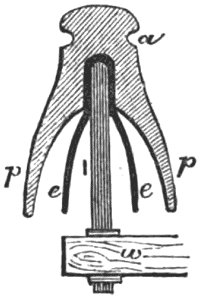[Book]
Publication: Electricity
London, England
p. 240-241, col. 1
·
·
149. The Line.—Telegraphic stations must be united by one insulated wire, either carried over land or under the sea. The insulation of land-lines is insured by attaching the wires to insulators fixed on posts some 20 feet high. The posts are placed at distances corresponding to the number of wires they have to carry. A distance of 80 yards is the ordinary distance for posts sustaining several wires, and 150 yards for those only supporting one. Insulators are of all shapes. Porcelain, though a better conductor than glass, is not so apt to attract moisture, and is the substance generally employed for them. The insulator known as Andrew's Insulator, and used by the United Kingdom Company, which is shown in section (fig. 134), is said to be very effectual. A bolt of iron, I, fixed to the cross-beam, w, of the telegraphic pole, is cemented into the ebonite cup or bell ee, which in turn is cemented into the porcelain bell pp. The porcelain bell acts as an umbrella to keep the wood to which it is fixed dry and insulating; that failing, the inside of the two cups is likely to remain dry and maintain insulation. The line-wire is kept fixed by binding wire into the groove a. The electricity has thus to travel over the outside and inside of both cups before it reaches the iron bolt, which is also coated with ebonite. Such insulators as the one described cannot be used in railway tunnels, as they get coated over inside and out with engine smoke, which, being conducting, quite impairs their efficiency. The leakage in a long line, notwithstanding the best insulation, is considerable. The loss at each post is insignificant, but when hundreds or thousands are taken into account it becomes decided, so that merely a fraction of the total current that sets out reaches the earth at the distant station. In rainy, and more especially in misty weather, the insulation suffers much.
 |
| Fig. 134 |
The wire most employed for telegraphic circuits is No. 8 (1/8th of an inch). The Electric Telegraph Company are beginning to use No. 4 wire on some of their long trunk lines.
·
·
